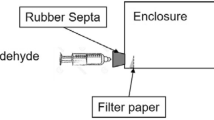Summary
The disinfection of operating theatres and adjoining areas is carried out with chemical disinfectants containing not only formaldehyde but also glutardialdehyde. The cleaning staff is therefore unavoidably exposed to these two substances. Adequate and correct evaluation of staff exposure must be based on exact quantification of these aldehydes in room air. The statutory MAK-levels of 0.5 ppm (formaldehyde) and 0.2 ppm (glutardialdehyde) call for highly sensitive and specific analytical methods for monitoring exposure that should be suited for personal measurings as well. Since previous methods have failed to meet these requirements, we have adapted a newly developed method for the specific measurement of formaldehyde and other aldehydes and ketones for the personal monitoring of formaldehyde and glutardialdehyde. Detailed personal measurings over whole shifts and of short-term peaks have yielded the following results: During routine disinfection activities in operating theatres using low concentrations of disinfectants, the limits prescribed by MAK can be respected. Disinfections to prevent notifiable infectious diseases in accordance with the Federal Epidemic Law (Bundesseuchengesetz) [10] involving the use of higher disinfectant concentrations are liable to exceed the MAK limits for formaldehyde and glutardialdehyde.
If for reasons of hygiene this excess exposure cannot be avoided, effective protection of the cleaning staff from unacceptably high concentrations of these substances can be ensured only by providing personal protective outfits.
Similar content being viewed by others
References
Binding N, Thiewens S, Witting U (1986) Spezifische Bestimmung von Formaldehyd und anderen Aldehyden und Ketonen bei ortsfester und personenbezogener Expositionskontrolle. Staub Reinhalt Luft 46:444–446
Bundesgesundheitsamt (1976) Richtlinie für die Erkennung, Verhütung und Bekampfung von Krankenhausinfektionen. Bundesgesundheitsbl 19:1–7
Bundesgesundheitsamt (1979) Anforderungen der Hygiene an die funktionelle und bauliche Gestaltung von Operationsabteilungen. Bundesgesundheitsbl 22:183–185
Bundesgesundheitsamt (1980) Durchführung der Desinfektion. Bundesgesundheitsbl 23:356–364
Bundesgesundheitsamt (1981) Erläuterungen zur Anwendung der Richtlinie des Bundesgesundheitsamtes fur die “Erkennung, Verhutung und Bekampfung von Krankenhausinfektionen”. Bundesgesundheitsbl 24:209–212
Bundesgesundheitsamt (1984) Formaldehyd. Kohlhammer, Verlag, Stuttgart
Bundesgesundheitsamt (1985a) Hausreinigung und Flächendesinfektion. Anlage zu Ziffer 6.12 der “Richtlinie für die Erkrankung, Verhutung und Bekämpfung von Krankenhausinfektionen“. Bundesgesundheitsbl 28:276–278
Bundesgesundheitsamt (1985b) Empfehlungen des Bundesgesundheitsamtes und der Bundesanstalt für Arbeitsschutz zur Vermeidung von gesundheitsschädigenden Gefahren beim Umgang mit Formaldehyd im medizinischen Bereich. Bundesgesundheitsbl 28:182–184
Bundesgesundheitsamt (1987) Liste der vom Bundesgesundheitsamt geprüften und anerkannten Desinfektionsmittel und -Gefahren. Bundesgesundheitsbl 30:279–292
Bundes-Seuchengesetz (1979) Gesetz zur Verhiitung und Bekampfung übertragbarer Krankheiten beim Menschen. Bundesgesundheitsbl I:2262–2281
Deutsche Forschungsgemeinschaft (1975) Formaldehyd, Methodennr. 1. In: Henschler D (Hrsg) Analytische Methoden zur Prüfung gesundheitsschadlicher Arbeitsstoffe. Bd. 1: Luftanalysen. Verlag Chemie, Weinheim
Deutsche Forschungsgemeinschaft (1977) Formaldehyd, Methodennr. 2. In: Henschler D (Hrsg) Analytische Methoden zur Prüfung gesundheitsschadlicher Arbeitsstoffe. Bd. 1: Luftanalysen. Verlag Chemie, Weinheim
Deutsche Forschungsgemeinschaft (1988) Maximale Arbeitsplatzkonzentrationen und biologische Arbeitsstofftoleranzwerte. VCH Verlagsgesellschaft mbH, Weinheim
Deutsche Gesellschaft fur Hygiene und Mikrobiologie (DGHM) (1987) VII. Liste der nach den “Richtlinien für die Prüfung chemischer Desinfektionsmittel” geprüften und von der DGHM als wirksam befundenen Desinfektionsverfahren. Stand: 31.3. 1987. mhp-Verlag GmbH, Wiesbaden
Elias I (1987) Bewertung von Arbeitsverfahren zur Desinfektion von Operationsräumen von Krankenhäusern nach der Konzentration von Formaldehyd in der Atemluft. Zbl Arbeitsmed 37:389–397
International Agency for Research on Cancer (1982) Some industrial chemicals and dyestuffs. IARC monographs on the evaluation of the carcinogenic risk of chemicals to humans, Vol. 29. WHO, Genova
International Agency for Research on Cancer (1987) Overall evaluations of carcinogenicity: an updating of IARC monographs Vol. 1 to 41. IARC monographs on the evaluation of carcinogenic risk of chemicals to humans. Supplement 7. WHO, Geneva
Knecht U, Woitowitz HJ (1979) Felduntersuchungen zur Belastung der Raumluft durch Formaldehyd in Kliniken und Instituten. Öff Gesundh Wesen 41:715–723
Lamalle Y, Torres J, Stoklov M, Mallion JM (1985) Le formol à l'Hôpital. Arch Mal Prof 46:429–430
Ohgke H (1980) Orientierende Messungen von Formalin-Konzentrationen in der Raumluft bei der Bettendesinfektion. 6. Symposion der Österr. Gesellsch. f. Hygiene, Mikrobiologie und Präventivmedizin: “Sterilisation — Desinfektion — Krankenhausreinigung”, Wien
Schlosser D, Marande JL, Brochard P, Proteau J (1988) La désinfection terminale des blocs opératoires par le formaldehydé gazeux ou en aérosol: comparaison de la nuisance des deux procédés. Arch Mal Prof 49:207–213
Technische Regel für Gefahrstoffe (TRGS) 402 (1986) Ermittlung und Beurteilung der Konzentrationen gefährlicher Stoffe in der Luft in Arbeitsbereichen. B Arb B1 11:92–96
Author information
Authors and Affiliations
Rights and permissions
About this article
Cite this article
Binding, N., Witting, U. Exposure to formaldehyde and glutardialdehyde in operating theatres. Int. Arch Occup Environ Heath 62, 233–238 (1990). https://doi.org/10.1007/BF00379439
Received:
Accepted:
Issue Date:
DOI: https://doi.org/10.1007/BF00379439




